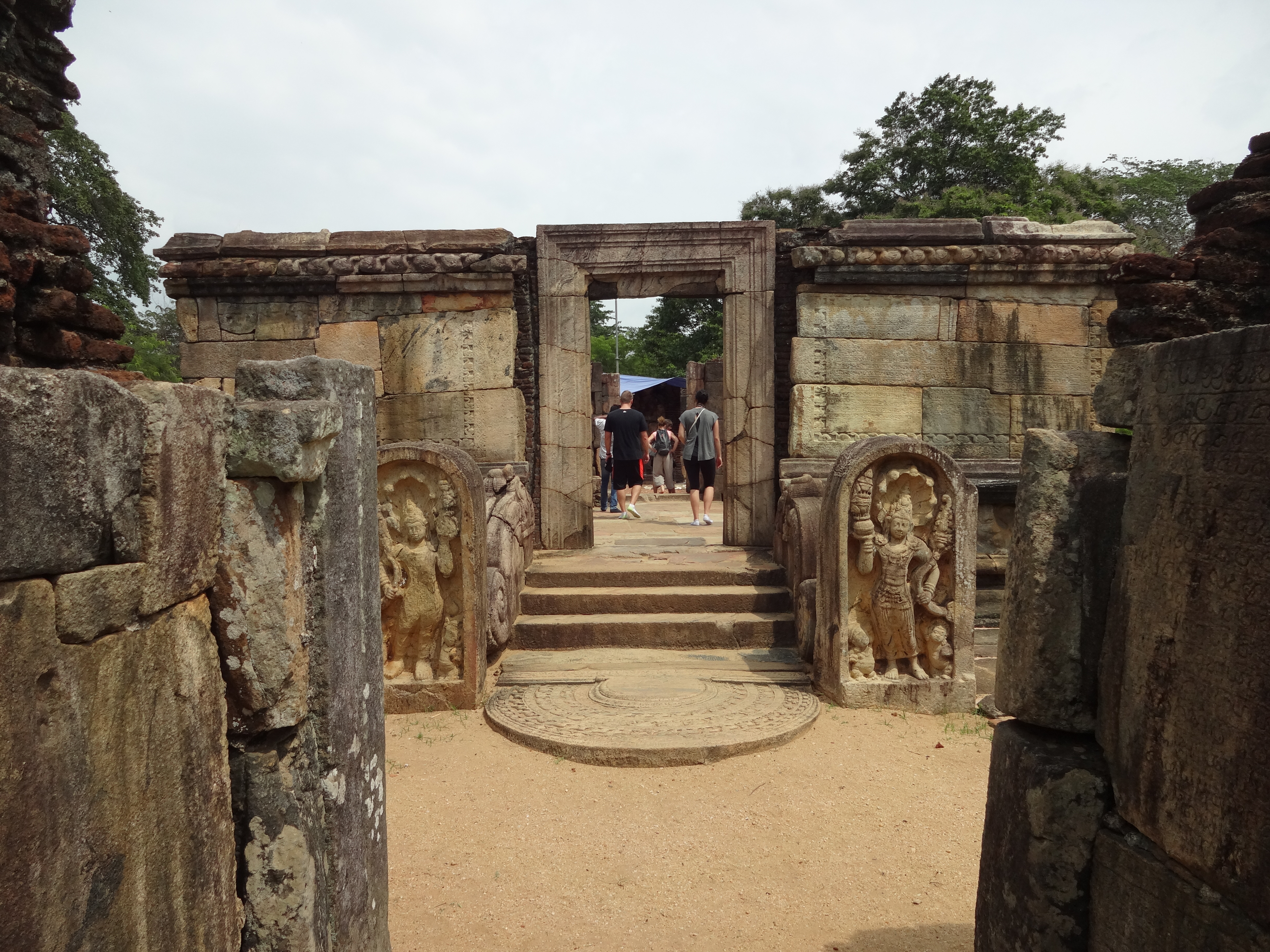OB03060 Poḷonnaruva Häṭa-dā-gē Inside Wall (fragments)
The Inner Shrine at the Hatadage, Polonnaruwa.
IN03080 Poḷonnaruva Häṭa-dā-gē Inside Wall Inscription
The inscription is engraved on a series of slabs originally built into an inside wall of the so-called Häṭa-dā-gē, ‘the Shrine of Sixty Relics’, at Poḷonnaruva. It was discovered by S. M. Burrows in 1885, along with another inscription in the vestibule of the shrine (IN03079) and one in the adjoining portico (IN03078). Consisting of eight lines, the inscription dates from the reign of Kīrti-Niśśaṅka-Malla (1187-1196 A.D.) and provides a tactfully worded exhortation to Buddhist monks to exercise care in the selection of persons for admission to the priesthood and to desist from doing things contrary to the teaching of the Buddha.
OB03059 Poḷonnaruva Häṭa-dā-gē Vestibule Wall
The Hatadage, Polonnaruwa. The vestibule wall inscription can be seen on the right in this photograph.
Detail of the vestibule wall-inscription at the Hatadage, Polonnaruwa.
IN03079 Poḷonnaruva Häṭa-dā-gē Vestibule Wall Inscription
The inscription is engraved on the front wall of the vestibule or pro-naos of the so-called Häṭa-dā-gē, ‘the Shrine of Sixty Relics’, at Poḷonnaruva. It was discovered by S. M. Burrows in 1885, along with another inscription inside the shrine (IN03080) and one in the adjoining portico (IN03078). The inscription dates from the reign of Kīrti-Niśśaṅka-Malla (1187-1196 A.D.), whom it refers to as Siṁhapureśvara Laṁk󠅛eśvara Kāliṅga-Cakravartī. The text consists of 17 lines engraved within a double border featuring a band of haṁsas (swans) and another of foliate ornament. It describes some of Niśśaṅka-Malla’s administrative and charitable acts.
OB03058 Poḷonnaruva Häṭa-dā-gē Portico Slabs
Entrance to the Hatadage, Polonnaruwa. The slab inscription can be seen on the right in this photograph.
IN03078 Poḷonnaruva Häṭa-dā-gē Portico Slab Inscription
The inscription is engraved on the portico of the so-called Häṭa-dā-gē, ‘the Shrine of Sixty Relics’, at Poḷonnaruva. It was discovered by S. M. Burrows in 1885; Burrows also discovered two further inscription in the shrine itself (IN03079 and IN03080). The inscription dates from the reign of Kīrti-Niśśaṅka-Malla (1187-1196 A.D.) and consists of 23 lines, starting with a Sanskrit stanza in triṣṭup śālinī metre and ending in a Sinhalese quatrain. Both of these stanzas contain Niśśaṅka-Malla’s appeal to future kings to protect and preserve the Dharma. The rest of the inscription describes some of Niśśaṅka-Malla’s administrative and charitable acts, including the building in stone of the Vaṭa-geya (‘Rotunda’), the (Niśśaṅka-latā-maṇḍapaya ‘Niśśaṅka flower-trail hall’), and the Niśśaṅka-daḷadā-geya (‘Niśśaṅka tooth-relic house’) at Poḷonnaruva.
OB03054 Poḷonnaruva Raja-Māḷigāva Pillar of Mahinda IV
IN03074 Poḷonnaruva Raja-Māḷigāva Pillar Inscription of Mahinda IV
The inscription is engraved on three sides of a quadrangular pillar, which was discovered in or before 1905 at the site of the so-called Raja-māḷigāva (royal palace) in the Citadel of Poḷonnaruva. In 1912, Wickremasinghe reported that the pillar had been moved to the premises of the Archaeological Commissioner at Tōpa-väva. The inscription consists of 118 lines in the Sinhalese alphabet of the early eleventh century A.D. It is dated to the eighth year of the reign of king Siri San̆g-bo and records the granting of immunities to a village called Kiṇigama, belonging to Kuḷu-Tisa-rad-maha-vehera of the Mahāvihāra Nikāya, situated in the Eastern Quarter. Wickremasinghe suggests that the biruda Siri San̆g-bo refers in this instance to Mahinda IV. The first three lines of the inscription are almost word-for-word identical with the two slab inscriptions of Mahinda IV at Jētavanārāma (IN03061 and IN03062).




